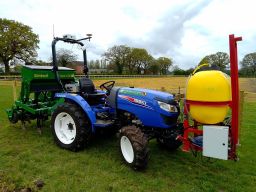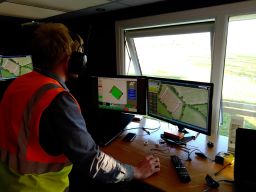Story highlights
Machines replace human workers in planting, growing and harvesting a barley crop
Professor: "Automation is feasible everywhere, but ... it only makes sense in certain situations"
A farm in the United Kingdom is the first in the world to successfully plant, tend and harvest a crop without a single person ever setting foot in the field, according to researchers and developers involved in the project.
From sowing the seeds to picking the grain, human workers were replaced with automated machines operated from a control room. The project, called Hands Free Hectare, was completed last month with a yield of 4 1/2 tons of barley, according to news releases.
The automated farm was a joint venture by Harper Adams University in Shropshire, England, and Precision Decisions, a farming specialist company in York.
“Previously, people have automated sections of agricultural systems, but funding and interest generally only goes towards one single area,” said Kit Franklin, an agricultural engineer on the project.
Experts agree that automation technology has been available for some time now, but in recent years its implementation has been accelerated by decreasing costs and changing demographics in the workforce.

“The rising cost of labor is a huge driver in the field of agriculture technology,” explained Matt Nielsen of Autonomous Solutions, a Utah-based company that converts vehicles from manual to robotic control. “It makes sense when you compare the cost of technology to the cost of labor.”
Harbinger of what’s possible
However, there are limitations still to be assessed. For example, fresh fruits and vegetables are more delicate than sturdy grains and may be more susceptible to bruising in a harvest void of human touch.
There are also social and country-specific considerations. In Japan, for instance, agricultural automation may be a necessity; in India, it could mean unemployment for millions.
“Technically, complete automation is feasible everywhere, but economically and socially it only makes sense in certain situations,” said David Zilberman, a professor of agricultural and resource economics at the University of California, Berkeley.
Nonetheless, the complete mechanization accomplished in the UK is a harbinger of what’s possible in agriculture production, according to experts.
At Hands Free Hectare, agronomists and engineers used customized tractors and drones to cultivate the barley from an area roughly equivalent to two and a half acres.
Drones with multispectral sensors took aerial images of the field, while smaller machines at crop level took samples to assess what fertilizers to apply and where. Live camera feeds were used to detect invasive weeds or disease.
Earlier this year, the United Nations’ Food and Agriculture Organization stressed the need for technological innovation to create alternatives to high-input and destructive farming practices – methods that are unsustainable to meet global food needs, the FAO warned.

“Automation will facilitate a sustainable system,” said Hands Free Hectare’s Franklin. “Different areas of the field, and possibly even individual plants can be treated separately.”
The success at Hands Free Hectare also demonstrates the economic feasibility of complete automation, researchers say.
The project was funded in part by Innovate UK, a government agency that helps British economic sectors transform from low-tech to high-tech. The whole enterprise cost around $250,000, Innovate UK said in a statement.
“The project itself was incredibly good value for money,” said Martin Abell, a mechatronics researcher at Precision Decisions. “This was only possible through the use of open-source software, allowing us to program our vehicles through low-cost drone-based autopilots.”
Skill set shift
Researchers maintain that even machinery produced commercially – as opposed to the prototypes used at Hands Free Hectare – would be priced comparatively to traditional agricultural equipment.
“Just as computers used to be expensive, the cost of automation technology is decreasing and won’t be a barrier for even small farms,” explained Michael Boehlje, a professor of agricultural economics at Purdue University.
Hands Free Hectare says the project is not about putting farmers out of work but instead modernizing their position.
“A change in skill set is inevitable,” said Abell. “Roles would transition, enabling the farmers to better use their time managing their farm and crops, opposed to carrying out the seemingly robotic task of driving up and down a field in a straight line.”
By leaving the “robotic” jobs to the robots, agriculturalists say farmers could create more efficient work-flows free of burdensome labor.
“A farmer once told me he adopted robotic farming systems so he could have a life,” recalled Boehlje.
With the success of the summer harvest, Hands Free Hectare plans to continue its research into farming without any human tillage. At the end of October, the team plans to plant a full crop of winter wheat.
But first, they plan to celebrate their success – by brewing their own beer, made from the spring barley harvested last month.

